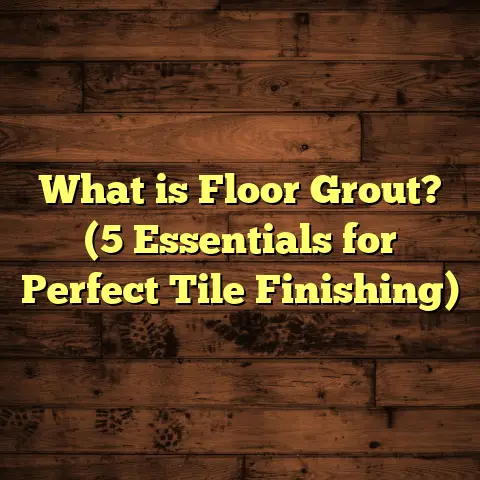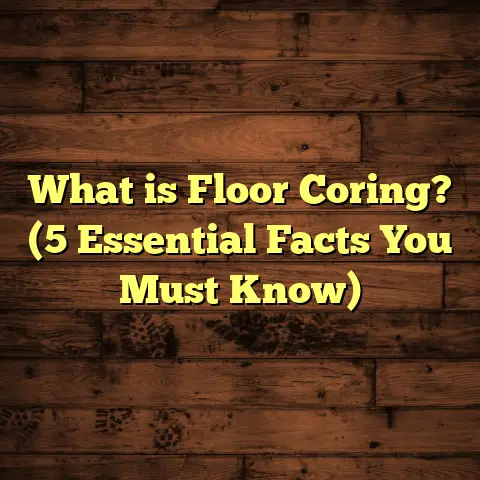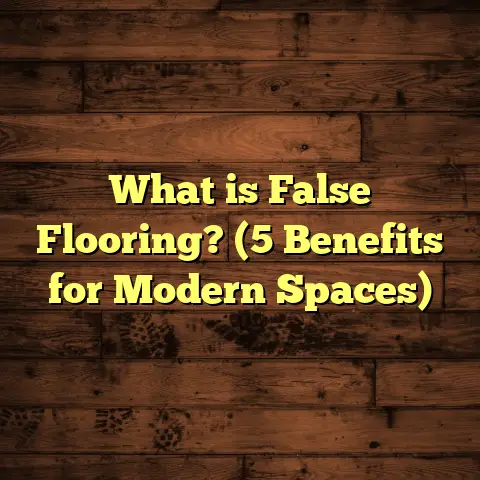What is a Floating Floor System? (5 Benefits You Must Know!)
I still remember the first time I decided to replace the flooring in my old home. It was more than just a renovation project—it felt like giving new life to a space where countless memories had been made. The old floor was tired and worn, and I wanted something that would not only look good but feel good underfoot and stand the test of time. That’s when I came across floating floor systems. At first, I was skeptical. Floors that just “float” above the subfloor? No nails, no glue? It seemed almost too good to be true. But over the years, after installing floating floors on dozens of projects and learning the ins and outs, I’ve come to appreciate how smart and practical this method really is.
If you’re curious about floating floors and why they’ve become a favorite for so many homeowners and contractors alike, stick with me. I’ll walk you through everything—from what a floating floor system is, how it works, its benefits, materials used, cost considerations, and maintenance tips—based on real-world experience and data.
What Is a Floating Floor System?
You might have seen or even walked on a floating floor without realizing it. But what exactly makes a floor “floating”?
A floating floor system is a method of installation where the flooring planks or tiles are not fixed directly to the subfloor underneath with nails, glue, or staples. Instead, the individual planks are connected to each other and rest loosely on top of an underlayment. The entire floor “floats” over the surface below.
This design allows the floor to move slightly—expand or contract—with changes in temperature and humidity without cracking, buckling, or warping. The boards are usually connected by a tongue-and-groove system or a click-lock mechanism that locks them tightly together.
Unlike traditional hardwood floors which are typically nailed down directly to a wooden subfloor or glued over concrete, floating floors rely on the interlocking strength of the planks themselves. This approach makes installation easier and often faster.
How Does This Work in Practice?
Imagine fitting together pieces of a puzzle; each plank locks into the next perfectly. Beneath these planks lies an underlayment—a thin cushion made from foam, cork, rubber, or felt—which helps absorb sound, provides insulation against cold floors, and acts as a moisture barrier in some cases.
The underlayment also smooths out minor imperfections in the subfloor, so you don’t need perfect leveling before installation.
This floating mechanism is especially useful in environments where humidity fluctuates. Wood naturally expands when humid and contracts when dry. If flooring is fixed rigidly to the subfloor with nails or glue, these natural movements can cause damage over time. Floating floors can move slightly as a whole unit, preventing these problems.
Different Types of Floating Floors
Floating floors aren’t limited to one material type. Here are the main materials commonly installed as floating floors:
- Laminate Flooring: Probably the most popular floating floor option because it mimics wood or stone looks at a fraction of the cost.
- Engineered Hardwood: Real wood veneer layered over plywood or HDF (high-density fiberboard), offering better stability than solid wood.
- Luxury Vinyl Plank (LVP): Vinyl planks with click-lock edges that provide waterproof options and durability.
- Bamboo Engineered Flooring: Similar to engineered hardwood but made from bamboo layers.
Each material has its own characteristics, advantages, and care requirements, but all share the common feature of being installed using floating floor systems.
Five Benefits You Must Know About Floating Floors
After installing countless flooring projects using floating systems in homes and commercial spaces, here are five key benefits that have consistently stood out to me:
1. Quick and Easy Installation Saves Time and Money
One of the biggest advantages I’ve experienced with floating floors is how fast they can be installed compared to traditional flooring methods.
For example, when I installed a laminate floating floor across a 600-square-foot area for a client last year, it took just two days from prep work to finishing. No waiting for glue to dry or nails to be hammered down meant less downtime for homeowners.
Because the planks lock together like puzzle pieces without adhesives or nails, even DIYers can handle large portions of the installation if they have patience and follow instructions carefully.
This speed translates into lower labor costs—something clients always appreciate. Plus, if you’re renting space or running a business that can’t afford long closures during renovations, floating floors limit disruption.
2. Cost-Effective Without Sacrificing Style
Floating floors tend to be more affordable than traditional hardwood or tile installations for several reasons:
- The materials like laminate and engineered wood designed for floating installation are generally cheaper.
- The labor cost is lower due to faster installation.
- Minimal subfloor prep is often needed.
- There’s usually less waste because planks are easier to cut and fit precisely.
I’ve found that using tools like FloorTally helps me give clients detailed cost estimates quickly. FloorTally factors in local material prices, labor rates, waste percentages (usually 5-10%), and underlayment costs so budgets aren’t just guesses—they’re grounded in real data.
For instance, a recent project I managed showed laminate floating floors at around $5-$7 per square foot installed, compared to $10-$15 for traditional nailed hardwood floors. That’s a significant difference when flooring large spaces.
3. Can Be Installed Over Many Subfloors
One challenge with traditional hardwood floors is that they require very smooth and level subfloors. Uneven concrete slabs or damaged plywood subfloors often need expensive repairs before nailing hardwood down.
Floating floors don’t have this limitation because their underlayment absorbs small irregularities. In one basement renovation I did where the concrete slab had cracks and dips, installing a floating floor over an appropriate moisture barrier saved hundreds of dollars in leveling costs.
Plus, floating floors can be installed on top of existing flooring like vinyl or tile if it’s still flat and stable enough—making them great candidates for quick remodels without demolition.
4. Comfort Underfoot and Sound Dampening
Standing on hardwood nailed to subfloors can sometimes feel hard or cold. Floating floors offer extra cushioning thanks to their underlayment layers.
I noticed this difference firsthand when installing cork underlayment beneath engineered hardwood planks in a family room project. The floor felt warmer and softer underfoot compared to typical hardwood floors I’d worked on before.
The same underlayment reduces noise transmission between floors—great for condos or multi-story homes. Studies report noise reduction improvements up to 20 decibels using soundproofing underlayments beneath floating floors.
5. Easier Repairs and Maintenance
When damage happens—say a plank gets scratched or stained—floating floors are easier to repair because individual boards can be removed without disturbing the entire floor.
I recall one job where a client spilled red wine on laminate flooring. Instead of replacing the whole floor or sanding it down like solid wood, I was able to remove just the affected planks and replace them seamlessly.
This modular nature extends the lifespan of your floor and keeps maintenance simpler.
My Personal Journey with Floating Floors: Lessons Learned
I want to share a story that shaped how I approach floating floors today.
Early in my flooring career, I worked on an older home with original hardwood nailed directly to subflooring. The floors had buckled badly due to moisture issues from foundation leaks. The homeowners didn’t want to demolish everything but needed a durable new surface fast.
I suggested installing engineered hardwood as a floating floor over a moisture barrier and soundproofing underlayment. It was their first time hearing about floating systems.
The installation went smoothly; they were amazed at how quickly their living room transformed without weeks of construction dust or noise.
Three years later, I visited for routine maintenance and noticed the floor remained flat with no signs of warping—even after harsh winters with fluctuating indoor humidity levels.
That project taught me how resilient floating floors can be when done right—and how they can be perfect solutions in older homes with tricky subfloor conditions.
Diving Deeper: Materials Best Suited for Floating Floors
Not all flooring materials are created equal when it comes to floating systems. Here’s what I’ve learned about the pros and cons of popular types:
Laminate Flooring
Laminate dominates the floating floor market because it’s affordable and easy to install. It’s made from high-density fiberboard topped with photographic layers simulating wood or stone textures beneath a protective clear coat.
Laminate boards typically have click-lock edges designed specifically for floating installation. They’re resistant to scratches and stains but can be damaged by standing water since the core material swells when wet.
According to industry stats, laminate flooring sales have grown roughly 5% year-over-year globally due to these qualities.
Engineered Hardwood
Engineered hardwood consists of thin layers of real wood on top of plywood or HDF core layers arranged in cross-grain patterns for stability.
It offers genuine wood aesthetics but with less expansion/contraction than solid hardwood—making it suitable for floating installations in many cases.
Wear layers vary from 2mm up to 6mm; thicker wear layers provide sanding options for longevity.
From my experience, engineered hardwood floats best over plywood subfloors but can work well on concrete with proper underlayment and moisture barriers.
Luxury Vinyl Plank (LVP)
Vinyl planks have improved massively in quality over recent years. Many now feature click-lock systems designed for floating installation alongside waterproof cores ideal for kitchens and bathrooms.
LVP offers excellent durability against spills, scratches, and heavy foot traffic. Some products come with attached underlayments simplifying installation further.
In commercial settings like retail stores where heavy loads occur daily, LVP floating floors have proven reliable while also attractive aesthetically.
Bamboo Engineered Flooring
Bamboo engineered flooring shares similar properties with engineered hardwood but uses bamboo layers known for rapid growth and sustainability.
It’s becoming popular among eco-conscious homeowners seeking floating floor systems with natural appeal.
One tip: always verify manufacturer recommendations before installing bamboo as floated since some products require glue-down methods depending on core composition.
Managing Moisture: What You Need to Know
Moisture is one of the biggest enemies of wood-based flooring products. Floating floors handle moisture better than nailed-down solid wood because they aren’t fixed directly onto potentially damp subfloors. However:
- Always install a vapor barrier on concrete slabs before laying floating floors.
- Use moisture-resistant underlayments in basements or areas prone to humidity.
- Avoid standing water spills; clean them quickly.
In one project covering 800 square feet in a basement family room near Chicago, we used an advanced polyethylene vapor barrier plus cork underlayment beneath engineered hardwood floating floors. After two years with snow melting tracked inside regularly from outside boots, no signs of moisture damage appeared—a huge relief for homeowners worried about mold or warping.
Cost Breakdown: How I Use FloorTally for Accurate Estimates
Budgeting flooring projects has always been a challenge—materials vary widely in price depending on quality and region; labor costs fluctuate; waste factors add unpredictability; plus you have accessories like trims and underlayments to consider.
FloorTally is an online tool I discovered that consolidates these elements in one place so I can generate accurate cost estimates quickly.
By inputting:
- Room dimensions (length x width)
- Selected flooring type & style
- Underlayment preference
- Regional pricing data (material + labor)
- Waste factor (usually 5-10%)
FloorTally spits out detailed cost breakdowns including material totals, labor costs based on local averages, and total project price estimates.
This makes conversations with clients easier because I’m not guessing prices—I’m presenting researched figures reflecting real market conditions.
For example: On a recent condo renovation where clients wanted LVP floating floors installed over existing tile, FloorTally helped me show them total costs around $8 per square foot inclusive of labor versus $12 per square foot if we opted for glued-down tile replacement.
This level of transparency builds trust upfront—and helps avoid budget blowouts later on due to unforeseen expenses.
Durability: How Long Can Floating Floors Last?
People often ask me: “Are floating floors durable enough? Will they stand up to kids and pets?”
From my experience:
- Quality laminate floors last 10-25 years depending on wear layer thickness.
- Engineered hardwoods with proper care last 20+ years.
- LVP can last over 20 years even in high traffic areas.
Durability depends heavily on product quality and installation precision—poor installation can void warranties or lead to early failure regardless of product specs.
Proper maintenance (which we’ll cover shortly) also plays a big role in longevity.
Step-by-Step: What Installation Looks Like
For those curious about installation details—here’s what you can expect during a typical floating floor installation:
- Prepare Subfloor: Remove old flooring if necessary; clean thoroughly; patch any holes or cracks.
- Check Levelness: Floating floors tolerate minor imperfections but more than 3/16″ variance over 10 feet may need leveling compound.
- Lay Vapor Barrier: On concrete slabs or humid areas install polyethylene sheets or specialized moisture barriers.
- Install Underlayment: Roll out foam/cork/rubber underlayment ensuring seams are tight.
- Start Laying Planks: Begin along one wall placing planks side by side using locking mechanism; stagger joints for strength.
- Cut Planks at Ends: Use saws for precise cuts around obstacles or room edges.
- Leave Expansion Gaps: Leave usually 1/4″ gaps around perimeter for natural expansion/contraction.
- Install Trim/Molding: Cover expansion gaps with baseboards or quarter-round trims.
- Clean Up: Remove debris; sweep/vacuum floor before use.
A professional installer completes this process efficiently while maintaining attention to detail critical for long-term performance.
Maintaining Your Floating Floor: Tips from the Field
Maintenance isn’t complicated but doing it right keeps your floor looking fresh longer:
- Use damp mops only; avoid soaking water which damages laminate cores.
- Place pads under furniture legs to prevent dents/scratches.
- Clean spills immediately—especially liquids that stain like wine or juice.
- Use manufacturer-recommended cleaners (many laminate brands sell specific products).
- Avoid abrasive scrubbers that wear down protective coatings.
- Check edges occasionally to ensure expansion gaps remain clear—not filled with debris restricting movement.
My clients who follow these simple guidelines usually enjoy flawless floors for well over a decade without refinishing or replacement needs.
Case Study: Turning Around an Old Basement with Floating Floors
Here’s one more story about how effective floating floors can be:
A client approached me with an unfinished basement plagued by cold concrete slabs and uneven surfaces. They wanted a warm family space quickly without extensive demolition costs.
We chose waterproof LVP planks installed as a floating floor using thick foam underlayment plus moisture barrier sheets underneath.
The total space was about 1,000 square feet; installation took three days including prep work.
Post-installation feedback? The family loved how warm the floor felt compared to bare concrete; kids could play safely without worries about cold drafts; cleanup was easy; plus minimal noise passed upstairs thanks to soundproofing qualities inherent in the system.
This project highlighted how versatile floating floors can be—not only stylistically but functionally—bringing new life into previously unusable spaces affordably and efficiently.
If you’re thinking about upgrading your flooring but want something practical yet stylish that won’t break your back during installation or your budget—floating floors deserve serious consideration based on everything I’ve seen firsthand over years of projects big and small.
Have you ever lived with or installed a floating floor? What challenges did you face? Or maybe you’re planning one now? Feel free to ask me any questions—I’m happy to share what I’ve learned!





